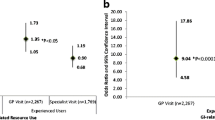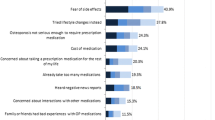Abstract
Summary
We describe complementary and alternative medicine use (CAM) in 360 patients attending osteoporosis clinics. Of these patients, 57% were CAM users. Predictors of CAM use included lower mental quality of life, younger age and higher education. Less than half of CAM use was disclosed to physicians, despite potential adverse interactions.
Introduction
The prevalence of complementary and alternative medicine (CAM) use in osteoporosis clinics is not known. The objective of this study was to describe the pattern of CAM use in this population.
Methods
We performed a cross-sectional study of 360 patients attending academic osteoporosis clinics in Toronto, Canada in 2001. Subjects completed a self-administered questionnaire on CAM use. Health-related quality of life (HQL) was measured with the Short-Form 36v2. Comparative statistics and logistic regression were performed to identify sociodemographic, HQL and clinical correlates of CAM use.
Results
More than 80% of participants were women, Caucasian and had at least a high school education. Of subjects, 57% used CAM in the previous year. Only 44% of CAM use was disclosed to a medical doctor. CAM users and non-users did not differ in clinical characteristics such as bone mineral density, level of comorbidity and fracture history. In univariate analysis, CAM users were less satisfied with conventional medicine. However, when we explored patient satisfaction, comorbidities and sociodemographic as predictors for CAM use, the multivariable analyses showed that lower mental HQL, younger age, and post-secondary education were the only significant predictors. We identified 35 cases in which the utilization of CAM supplements could possibly exacerbate existing medical conditions.
Conclusion
Patients attending osteoporosis clinics frequently use CAM. Conceptually, the predictors of use identified in this study may fit into a socio-behavioral model that helps explain why people turn to CAM. Physicians may need to elicit a history of CAM use more vigilantly so as to better screen for possible adverse clinical interactions.
Similar content being viewed by others
References
Millar WJ (1997) Use of alternative health care practitioners by Canadians. Can J Public Health 88:154–158
Eisenberg DM, Davis RB, Ettner SL et al (1998) Trends in alternative medicine use in the United States, 1990–1997: results of a follow-up national survey. JAMA 280:1569–1575
Tindle HA, Davis RB, Phillips RS et al (2005) Trends in use of complementary and alternative medicine by US adults: 1997–2002. Altern Ther Health Med 11:42–49
Verhoef MJ, Hagen N, Pelletier G et al (1999) Alternative therapy use in neurologic diseases: use in brain tumor patients. Neurology 52:617–622
Pioro-Boisset M, Esdaile JM, Fitzcharles MA (1996) Alternative medicine use in fibromyalgia syndrome. Arthritis Care Res 9:13–17
Ganguli SC, Cawdron R, Irvine EJ (2004) Alternative medicine use by Canadian ambulatory gastroenterology patients: secular trend or epidemic? Am J Gastroenterol 99:319–326
Eisenberg DM, Kessler RC, Foster C et al (1993) Unconventional medicine in the United States. Prevalence, costs, and patterns of use. N Engl J Med 328:246–252
MacLennan AH, Wilson DH, Taylor AW (1996) Prevalence and cost of alternative medicine in Australia. Lancet 347:569–573
Sirois FM, Gick ML (2002) An investigation of the health beliefs and motivations of complementary medicine clients. Soc Sci Med 55:1025–1103
Astin JA (1998) Why patients use alternative medicine: results of a national study. JAMA 279:1548–1553
Seidl MM, Stewart DE (1998) Alternative treatments for menopausal symptoms. Systematic review of scientific and lay literature. Can Fam Physician 44:1299–1308
Kam IW, Dennehy CE, Tsourounis C (2002) Dietary supplement use among menopausal women attending a San Francisco health conference. Menopause 9:72–78
Daniel W (1999) Biostatistics: A Foundation for Analysis in the Health Sciences, 7th edn. John Wiley Sons, John Wiley Sons: New York
(2001) Population Counts, Land Area, Population Density and Population Rank, for Canada, Provinces and Territories, and Census Subdivisions (Municiplaities), 2001 Census. Statistics Canada
National Center for Complementary and Alternative Medicine. (2007) CAM Basics. Available at: http://nccam.nih.gov/health/whatiscam/. Accessed February 15, 2007
Burstein HJ, Gelber S, Guadagnoli E et al (1999) Use of alternative medicine by women with early-stage breast cancer. N Engl J Med 340:1733–1739
Moore AD, Petri MA, Manzi S et al (2000) The use of alternative medical therapies in patients with systemic lupus erythematosus. Trination Study Group. Arthritis Rheum 43:1410–1418
Ware JE Jr, Sherbourne CD (1992) The MOS 36-item short-form health survey (SF-36). I. Conceptual framework and item selection. Med Care 30:473–483
Hopman WM, Towheed T, Anastassiades T et al (2000) Canadian normative data for the SF-36 health survey. Canadian Multicentre Osteoporosis Study Research Group. CMAJ 163:265–271
Charlson ME, Pompei P, Ales KL, MacKenzie CR (1987) A new method of classifying prognostic comorbidity in longitudinal studies: development and validation. J Chronic Dis 40:373–383
Chaudhry S, Jin L, Meltzer D (2005) Use of a self-report-generated Charlson Comorbidity Index for predicting mortality. Med Care 43:607–615
Kanis JA, Melton LJ 3rd, Christiansen C, Johnston CC, Khaltaev N (1994) The diagnosis of osteoporosis. J Bone Miner Res 9:1137–1141
Tenenhouse A, Joseph L, Kreiger N et al (2000) Estimation of the prevalence of low bone density in Canadian women and men using a population-specific DXA reference standard: the Canadian Multicentre Osteoporosis Study (CaMos). Osteoporos Int 11:897–904
(2001) Median total income, by family type, by census metropolitan area. Statistics Canada
Yue QY, Jansson K (2001) Herbal drug curbicin and anticoagulant effect with and without warfarin: possibly related to the vitamin E component. J Am Geriatr Soc 49:838
Corrigan JJ Jr, Ulfers LL (1981) Effect of vitamin E on prothrombin levels in warfarin-induced vitamin K deficiency. Am J Clin Nutr 34: 1701–1705
Corrigan JJ Jr, Marcus FI (1974) Coagulopathy associated with vitamin E ingestion. JAMA 230:1300–1301
Monauni T, Zenti MG, Cretti A et al (2000) Effects of glucosamine infusion on insulin secretion and insulin action in humans. Diabetes 49:926–935
Adams ME (1999) Hype about glucosamine. Lancet 354:353–354
Schelling JR (2000) Fatal hypermagnesemia. Clin Nephrol 53:61–65
This P, De La Rochefordiere A, Clough K et al (2001) Phytoestrogens after breast cancer. Endocr Relat Cancer 8:129–134
Glazier MG, Bowman MA (2001) A review of the evidence for the use of phytoestrogens as a replacement for traditional estrogen replacement therapy. Arch Intern Med 161:1161–1172
Miller LG (1998) Herbal medicinals: selected clinical considerations focusing on known or potential drug-herb interactions. Arch Intern Med 158:2200–2211
Ernst E, Harkness E (2001) Spinal manipulation: a systematic review of sham-controlled, double-blind, randomized clinical trials. J Pain Symptom Manage 22:879–889
Monostory K, Vereczkey L, Levai F, Szatmari I (1998) Ipriflavone as an inhibitor of human cytochrome P450 enzymes. Br J Pharmacol 123:605–610
Alexandersen P, Toussaint A, Christiansen C, Devogelaer JP, Roux C, Fechtenbaum J, Gennari C, Reginster JY (2001) Ipriflavone in the treatment of postmenopausal osteoporosis: a randomized controlled trial. JAMA 285:1482–1488
Hsiao AF, Wong MD, Kanouse DE et al (2003) Complementary and alternative medicine use and substitution for conventional therapy by HIV-infected patients. J Acquir Immune Defic Syndr 33:157–165
Gagnon EM, Recklitis CJ (2003) Parents’ decision-making preferences in pediatric oncology: the relationship to health care involvement and complementary therapy use. Psychooncology 12:442–452
Arcury TA, Bell RA, Snively BM et al (2006) Complementary and alternative medicine use as health self-management: rural older adults with diabetes. J Gerontol B Psychol Sci Soc Sci 61:S62–S70
Andersen R, Newman JF (1973) Societal and individual determinants of medical care utilization in the United States. Milbank Mem Fund Q Health Soc. 51:95–124
Schwartz CE, Laitin E, Brotman S et al (1999) Utilization of unconventional treatments by persons with MS: is it alternative or complementary? Neurology 52:626–629
Acknowledgments
The authors are indebted to Ms. Cherry Mendoza and Ms. Susanne Stewart for their assistance in administering the questionnaire, Ms. Kathryn Herridge for obtaining patient information for us, Ms. Irene Ho for her assistance with the ethics applications, and Ms. Donna Cheung, Mr. Adrian Lau and Ms. Judy Lew for data collection and data entry. The authors would also like to thank the CAM practitioners who provided information on common alternative bone treatments.
Author information
Authors and Affiliations
Corresponding author
Additional information
Funding: Dr. A. M. Cheung is supported by a career award from the Canadian Institute of Health Research and an Ontario Premier’s Research Excellence Award, Dr. S. Jamal is supported by a career award from the Canadian Institute of Health Research, and Dr. G. A. Hawker receives support as the FM Hill Chair in Academic Women’s Medicine at Women’s College Hospital and the University of Toronto and as the recipient of a Senior Distinguished Research Investigator Award from The Arthritis Society of Canada.
Rights and permissions
About this article
Cite this article
Chong, C.A.K.Y., Diaz-Granados, N., Hawker, G.A. et al. Complementary and alternative medicine use by osteoporosis clinic patients. Osteoporos Int 18, 1547–1556 (2007). https://doi.org/10.1007/s00198-007-0417-x
Received:
Accepted:
Published:
Issue Date:
DOI: https://doi.org/10.1007/s00198-007-0417-x




